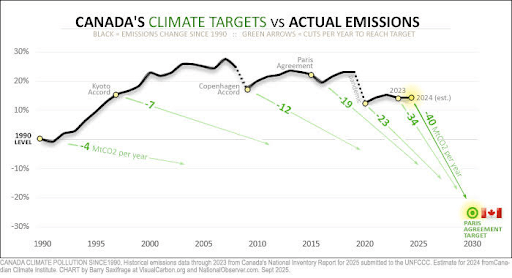Oil and gas emissions have risen at record production levels, offsetting any emissions reductions in other sectors like transportation (still at levels from 20 years ago) and buildings.
Political forces affecting Canada’s status on greenhouse gas emissions (GHGs) reduction have been influenced heavily recently by:
Political leadership – Parliament reconvened May 16, following an April 28 election, a new Prime Minister, Mark Carney, and once again a Liberal minority government. Prior to becoming Prime Minister, Carney emphasized a transition to net zero emissions from industrial GGEs. Carney’s position on climate change currently aligns climate action with economic strategy, for example, a low-carbon economy. The Liberals’ first action in Parliament was to drop the consumer carbon tax on April 1 (a flagship climate policy), given negative public sentiment and opposition party resentment, both of which polarized election issues. The industrial carbon tax remains a critical tool for decarbonization, with revenues reinvested in clean energy and emissions-reduction projects. The Toronto Star reported on September 10 that, during a Liberal caucus gathering, Carney repeated his “climate competitiveness strategy will focus on results rather than targets, on investments rather than bans.” Several Liberals attending created a sub-caucus group on September 11 as a forum for MPs to compare notes and speak with a collective voice for progressive policy and a stronger climate focus from Carney.
Technical Capacity – Canada monitors GGEs using a multi-faceted approach, including mandatory reporting from large emitters, yearly summaries to the UN’s National Inventory Reporting system, and specialized programs such as the National Forest Carbon Monitoring, Accounting and Reporting System. $200 billion was earmarked in 2023 for 149 programs, including the 2030 Emissions Reduction Plan, to reach Canada’s targets. The Liberals have committed to supporting private capital to drive competitiveness, promote clean energy, and invest in initiatives such as carbon capture.
Carney announced five initial projects on September 11 to fast-track investment under new legislation—the Building Canada Act (Bill C-5, June 26) —including a liquefied natural gas terminal expansion, two copper mining projects, a nuclear small modular reactor project, and the long-proposed expansion of the Port of Montreal. Unfortunately, once designated as projects of ‘national interest’, these initiatives override regulatory protections, including the Canadian Environmental Protection Act, rather than reinforcing environmental review.
A one-year delay in new-vehicle sales in 2026 is underway, impacting 20% of proposed sales as zero-emission vehicles due to new tariffs, competitiveness, and market realities. Ottawa is in conversation with industry about eliminating the fossil fuel emissions cap policy if it can reduce its carbon footprint through other measures. Canada’s increase in renewable energy involves the Smart Renewables and Electrification Pathways Program and the Emerging Renewable Power Program, which invest in grid modernization, energy storage, and new clean technologies.
The Media – Media has influenced citizen perceptions on climate change by challenging the fact that the government is falling short on its targets. Emissions in 2023 were 8% below 2005 levels, with the 2030 target basically “out of reach.” The Canadian Climate Institute (CCI) think tank’s September 18 report points out emissions flatlined in 2024 at 694 Mt CO2e, at a time when Canada faces compounding pressures such as devastating wildfires that highlight the rising costs of climate inaction, an economic slowdown tied to U.S. tariffs, intensifying competitiveness risks for industry, and affordability impacts on households. Oil and gas emissions have risen, especially the oilsands, at record production levels, offsetting any emissions reductions in other sectors like transportation (still at levels from 20 years ago) and buildings. “Missing our 2030 emissions target by a wide margin leaves Canada well off the path to 2035 and 2050 targets, forcing much deeper and more expensive emissions reductions later,” says Dave Sawyer, CCI’s principal economist. The media’s influence implies Canada’s future emissions look set to climb rather than decline.
Popular Opinion – This includes the fact that many competing issues still make climate change necessary, but are noticeably sliding in priority for action – see post 90. Fortunately, civil society and environmental leaders have challenged Bill C-5’s bypass of the process that sidelined Indigenous rights and democratic principles. Carney’s last-minute absence from the UN’s Climate Summit held on September 24 sends out a confusing message to Canadians. Earlier this year, Carney highlighted seven priorities, none of which were on climate change or climate targets. David Coletto of Abacus Data states, “Canadians need to see and feel momentum.”
Let’s keep climate change on the table. CCI encourages proven tools such as stronger methane regulations, industrial carbon pricing, and cleaner vehicles and fuels, so Canada’s hard-won climate progress doesn’t falter further.

This post was submitted by Climate Scorecard Canada County Manager, Diane Szoller.
Edited by Diana Gastelum.

